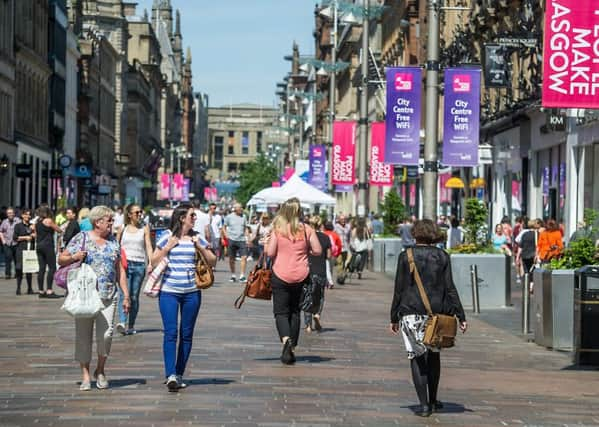Bill Jamieson: Dishonest pledges don't add up to a strategy


On the more hopeful side, there is continued relief that the impact of last June’s Brexit vote has not been as severe as feared. The economy has continued to grow – albeit at a slower pace. And numbers in work have continued to rise.
However, this growth has not been uniform. Scotland teeters on the brink of recession. And across the UK there is little sense of household well-being. Pressures are mounting on domestic budgets.
Advertisement
Hide AdAdvertisement
Hide AdHousehold spending grew at the slowest pace in more than two years in the first three months of this year – further evidence that higher prices have squeezed consumers and hit spending.
Figures from the Office for National Statistics (ONS) show consumer spending grew at the slowest pace since the end of 2014, pushing down overall economic growth to 0.2 per cent in the first quarter – well down on the 0.7 per cent growth rate notched up in the final three months of last year.
Meanwhile, the CBI has warned that households are “feeling the pinch” from higher inflation as retail sales fell back in May. Its survey of 117 retailers and wholesalers also showed sales volumes fell to a four-month low in May. Vehicle registrations slumped by 20 per cent year on year following the hike in car tax.
Here in Scotland hopes for a revival in the North Sea oil industry had been pinned on an agreement by the Organisation of Petroleum Exporting Countries (Opec) to hold back production and lift the oil price.
The world’s largest oil producers did indeed agree to hold back production for another nine months. But many in the market had hoped that Opec would have taken a more aggressive stance against oversupply. Thus, instead of an oil price rally, prices plunged by 4.5 per cent to $51.50 a barrel.
And as if the continuing slump in oil tax revenues was not enough, last week brought news of a fresh setback for the public finances, with public borrowing rising unexpectedly in April.
Public Sector Net Borrowing (PSNB), excluding public sector banks, stood at a three-year high of £10.4 billion last month. This was £1.2bn higher than the same month a year ago, well above market expectations for borrowing to fall to £8.7bn.
The rise was driven by higher spending amid an inflation-driven rise in debt interest payments – the great unmentionable of modern UK politics – as well as weaker tax revenues.
Advertisement
Hide AdAdvertisement
Hide AdCorporation tax, income tax and national insurance receipts all rose last month. But the 3.9 per cent rise in central government revenues was the slowest increase in a year.
There were also signs that higher inflation was also weighing on consumer spending. VAT receipts were almost flat, representing the worst April performance since 2009, while stamp duty receipts also fell.
The Office for Budget Responsibility (OBR) expects public borrowing to rise to £58.3bn this year as one-off factors that helped to push down borrowing last year unwind. These include changes to the calculation of corporation tax receipts and the timing of EU budget payments.
HSBC economist Liz Martins says reducing the deficit will be harder in the coming years as economic uncertainty continues and an ageing population puts more pressure on the public purse.
As for Public Sector Net Debt (PSND), this now stands at 86 per cent of gross domestic product. The OBR expects this to peak at 88.8 per cent of GDP this year.
This is the sombre background to the spending claims and counterclaims that continue to dominate the general election campaign. And in Scotland the fiery exchanges between Labour and the SNP continue to obsess about higher public spending and ever greater welfare and social care commitments.
According to the Institute for Fiscal Studies, neither the Conservatives nor Labour are being honest with voters about the economic consequences of their policy proposals.
The Conservatives have put very few detailed spending numbers in their manifesto. Labour, on the other hand, is proposing notable increases in tax and spending.
Advertisement
Hide AdAdvertisement
Hide AdIFS deputy director Carl Emmerson said neither manifesto gave voters an honest set of choices or addressed the long-term challenges the UK faced. “For Labour, we can have pretty much everything – free higher education, free childcare, more spending on pay, health, and infrastructure.
“The pretence is that can all be funded by faceless corporations and ‘the rich’,” he said. Labour’s calculations that £49bn a year could be raised from the wealthiest individuals and companies were flawed and would raise £40bn at most in the short term, and less in the long term, it said.
“There is a choice we can make as a country to have a bigger state – that would not make us unusual in international terms. But that comes at a cost in higher taxes, which would inevitably need to be borne by large numbers of us.”
As for the Conservatives, “additional funding pledges for the NHS and schools are just confirming that spending would rise in a way broadly consistent with the March budget”.
The IFS said the Tory plans “imply at least another five years of austerity, with the continuation of planned welfare cuts and serious pressures on the public services including on the NHS”.
The Conservatives’ plan to impose what the IFS called “very big cuts” to working-age welfare benefits would save £11bn annually by 2021-22, but would significantly cut the incomes of the poorest working age households.
The best we can hope for is that more attention is paid in the final two weeks of the election campaign to realistic and practical proposals for lifting our growth and productivity performance. And the need for these is all the more compelling as we look to a future with no immediate uplift in sight for households – and most economists predicting a continuing slowdown.